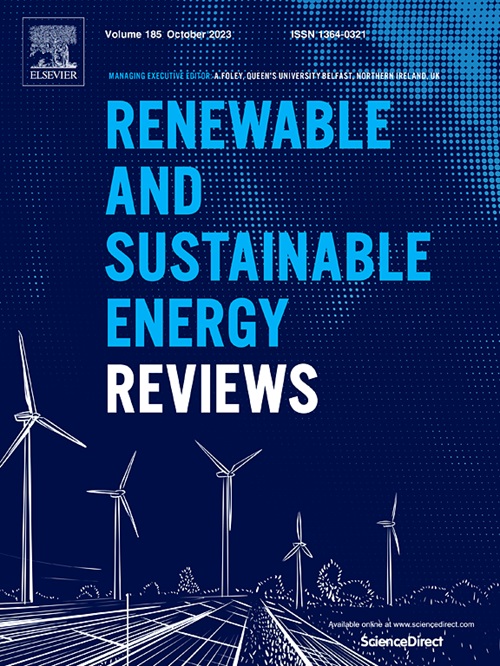Unlocking low-carbon hydrogen transportation through a cost-effective hybrid CO2/heat looping strategy
IF 16.3
1区 工程技术
Q1 ENERGY & FUELS
引用次数: 0
Abstract
Despite its crucial role in renewable energy networks, hydrogen transportation incurs elevated costs and high carbon intensity (CI). To enable affordable low-carbon hydrogen, this study examined integrating a closed CO2 and heat cycle via a dual solid carriers looping strategy to mitigate direct and indirect carbon emissions. A techno-environmental-economic analysis of the hydrogen transportation infrastructure was conducted on a large-scale overseas supply chain. This analysis involved base cases (i.e., LH2, LNH3, MeOH, formic acid, and dimethyl ether) and various combinations of hydrogen and CO2/heat dual carriers (i.e., CaO, ZnO, Li2O, and MgO). The results showed a considerable decrease in cost and carbon emissions through the integration of the CO2/heat closed cycle system. Particularly, the MeOH-ZnO route showed substantial improvement, achieving a CI reduction to 15.54 kgCO2-eq/kgH2 (i.e., 46 % lower than that of the MeOH route), with a cost of 6.0 USD/kgH2. In the projected 2050 scenario, employing the CO2/heat looping system further reduced CI to as low as 0.7 kgCO2-eq/kgH2 and a cost of up to 4.6 USD/kgH2, despite the use of costly renewable heat and direct air carbon capture. Integrating the CO2/heat looping system thus facilitates affordable, greener hydrogen transport, crucial for a sustainable energy economy.
通过具有成本效益的二氧化碳/热循环混合策略解锁低碳氢运输
尽管氢运输在可再生能源网络中发挥着至关重要的作用,但它会导致成本上升和碳强度(CI)升高。为了实现可负担得起的低碳氢,本研究考察了通过双固体载体循环策略整合封闭的二氧化碳和热循环,以减少直接和间接的碳排放。对大型海外供应链的氢运输基础设施进行了技术-环境-经济分析。该分析涉及基本情况(即LH2, LNH3, MeOH,甲酸和二甲醚)以及氢和CO2/热双载体(即CaO, ZnO, Li2O和MgO)的各种组合。结果表明,通过集成CO2/热密闭循环系统,可以显著降低成本和碳排放。特别是,MeOH- zno路线表现出明显的改善,CI降低到15.54 kgCO2-eq/kgH2(即比MeOH路线低46%),成本为6.0美元/kgH2。在预计的2050年情景中,尽管使用了昂贵的可再生热能和直接空气碳捕获,但采用二氧化碳/热循环系统进一步将CI降低至0.7 kgco2当量/kgH2,成本高达4.6美元/kgH2。因此,整合二氧化碳/热循环系统有助于实现价格合理、更环保的氢运输,这对可持续能源经济至关重要。
本文章由计算机程序翻译,如有差异,请以英文原文为准。
求助全文
约1分钟内获得全文
求助全文
来源期刊

Renewable and Sustainable Energy Reviews
工程技术-能源与燃料
CiteScore
31.20
自引率
5.70%
发文量
1055
审稿时长
62 days
期刊介绍:
The mission of Renewable and Sustainable Energy Reviews is to disseminate the most compelling and pertinent critical insights in renewable and sustainable energy, fostering collaboration among the research community, private sector, and policy and decision makers. The journal aims to exchange challenges, solutions, innovative concepts, and technologies, contributing to sustainable development, the transition to a low-carbon future, and the attainment of emissions targets outlined by the United Nations Framework Convention on Climate Change.
Renewable and Sustainable Energy Reviews publishes a diverse range of content, including review papers, original research, case studies, and analyses of new technologies, all featuring a substantial review component such as critique, comparison, or analysis. Introducing a distinctive paper type, Expert Insights, the journal presents commissioned mini-reviews authored by field leaders, addressing topics of significant interest. Case studies undergo consideration only if they showcase the work's applicability to other regions or contribute valuable insights to the broader field of renewable and sustainable energy. Notably, a bibliographic or literature review lacking critical analysis is deemed unsuitable for publication.
 求助内容:
求助内容: 应助结果提醒方式:
应助结果提醒方式:


